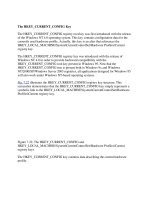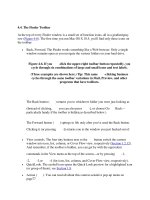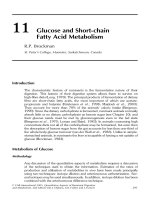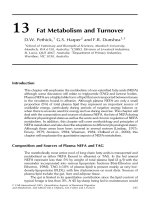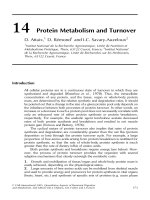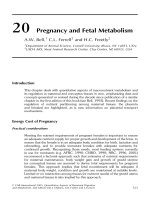Tài liệu The Role of Nutrition in Maintaining Health in the Nation’s Elderly: Evaluating Coverage of Nutrition Services for the Medicare Population ppt
Bạn đang xem bản rút gọn của tài liệu. Xem và tải ngay bản đầy đủ của tài liệu tại đây (1.81 MB, 383 trang )
NATIONAL ACADEMY PRESS
Washington, DC
Committee on Nutrition Services for
Medicare Beneficiaries
Food and Nutrition Board
INSTITUTE OF MEDICINE
The Role of
Nutrition in
Maintaining
Health in the
Nation’s Elderly
Evaluating Coverage of Nutrition Services
for the Medicare Population
NATIONAL ACADEMY PRESS • 2101 Constitution Avenue, N.W. • Washington, DC 20418
NOTICE: The project that is the subject of this report was approved by the Governing Board
of the National Research Council, whose members are drawn from the councils of the
National Academy of Sciences, the National Academy of Engineering, and the Institute of
Medicine. The members of the committee responsible for the report were chosen for their
special competences and with regard for appropriate balance.
This project was funded by the U.S. Department of Health and Human Services, Health Care
Financing Administration Contract No. 500-98-0275. Any opinion, findings, conclusions, or
recommendations expressed in this publication are those of the Institute of Medicine com-
mittee and do not necessarily reflect the view of the funding organization.
International Standard Book Number 0-309-06846-0
Library of Congress Card Number 00-103252
This report is available for sale from the National Academy Press, 2101 Constitution Av-
enue, N.W., Box 285, Washington, DC 20055; call (800) 624-6242 or (202) 334-3313 (in the
Washington metropolitan area), or visit the NAP’s on-line bookstore at www.nap.edu.
For more information about the Institute of Medicine or the Food and Nutrition Board, visit
the IOM home page at www.iom.edu
Copyright 2000 by the National Academy of Sciences. All rights reserved.
Printed in the United States of America
The serpent has been a symbol of long life, healing, and knowledge among almost all
cultures and religions since the beginning of recorded history. The image adopted as a
logotype by the Institute of Medicine is based on a relief carving from ancient Greece, now
held by the Staatliche Museen in Berlin.
The National Academy of Sciences is a private, nonprofit, self-perpetuating soci-
ety of distinguished scholars engaged in scientific and engineering research, dedi-
cated to the furtherance of science and technology and to their use for the general
welfare. Upon the authority of the charter granted to it by the Congress in 1863,
the Academy has a mandate that requires it to advise the federal government on
scientific and technical matters. Dr. Bruce M. Alberts is president of the National
Academy of Sciences.
The National Academy of Engineering was established in 1964, under the charter
of the National Academy of Sciences, as a parallel organization of outstanding
engineers. It is autonomous in its administration and in the selection of its mem-
bers, sharing with the National Academy of Sciences the responsibility for advis-
ing the federal government. The National Academy of Engineering also sponsors
engineering programs aimed at meeting national needs, encourages education
and research, and recognizes the superior achievements of engineers. Dr. William
A. Wulf is president of the National Academy of Engineering.
The Institute of Medicine was established in 1970 by the National Academy of
Sciences to secure the services of eminent members of appropriate professions in
the examination of policy matters pertaining to the health of the public. The
Institute acts under the responsibility given to the National Academy of Sciences
by its congressional charter to be an adviser to the federal government and, upon
its own initiative, to identify issues of medical care, research, and education. Dr.
Kenneth I. Shine is president of the Institute of Medicine.
The National Research Council was organized by the National Academy of Sci-
ences in 1916 to associate the broad community of science and technology with
the Academy’s purposes of furthering knowledge and advising the federal gov-
ernment. Functioning in accordance with general policies determined by the
Academy, the Council has become the principal operating agency of both the
National Academy of Sciences and the National Academy of Engineering in pro-
viding services to the government, the public, and the scientific and engineering
communities. The Council is administered jointly by both Academies and the
Institute of Medicine. Dr. Bruce M. Alberts and Dr. William A. Wulf are chairman
and vice chairman, respectively, of the National Research Council.
National Academy of Sciences
National Academy of Engineering
Institute of Medicine
National Research Council
v
COMMITTEE ON NUTRITION SERVICES FOR
MEDICARE BENEFICIARIES
VIRGINIA A. STALLINGS (Chair), Division of Gastroenterology and
Nutrition, The Children’s Hospital of Philadelphia, Pennsylvania
LAWRENCE J. APPEL, Welch Center for Prevention, Epidemiology
and Clinical Research, John Hopkins School of Hygiene and Public
Health, Baltimore, Maryland
JULIA A. JAMES, Principal, Health Policy Alternatives, Washington,
D.C.
GORDEN L. JENSEN, Division of Gastroenterology and Nutrition,
Vanderbilt University Medical Center, Nashville, Tennessee
ELVIRA Q. JOHNSON, Clinical Nutrition Services, Cambridge Health
Alliance, Massachusetts
JOYCE K. KEITHLEY, Rush University College of Nursing, Rush-
Presbyterian-St. Luke’s Medical Center, Chicago, Illinois
ESTHER F. MYERS, 60th Diagnostics and Therapeutics Squadron/
SGOD, United States Air Force, Travis Air Force Base, California
F. XAVIER PI-SUNYER, Division of Endocrinology, Diabetes, and
Nutrition, St. Luke’s/Roosevelt Hospital Center, Columbia
University College of Physicians and Surgeons, New York
HAROLD POLLACK, Health Management and Policy, University of
Michigan, Ann Arbor
CAROL PORTER, Nutrition Services and Dietetic Internship,
University of California at San Francisco
DAVID B. REUBEN, Division of Geriatrics, University of California,
Los Angeles
ROBERT S. SCHWARZ, Division of Geriatrics Medicine, University of
Colorado, Denver
ANNALYNN SKIPPER, Nutrition Consultation Service, Rush-
Presbyterian-St. Luke’s Medical Center, Chicago, Illinois
LINDA G. SNETSELAAR, Department of Preventive Medicine and
Environmental Health, University of Iowa, Iowa City
Staff
ROMY GUNTER-NATHAN, Study Director
GERALDINE KENNEDO, Project Assistant
CARMIE CHAN, Project Assistant
EDEN RAUCH, Intern (June to August 1999)
vi
FOOD AND NUTRITION BOARD
CUTBERTO GARZA (Chair), Division of Nutrition, Cornell University,
Ithaca, New York
JOHN W. ERDMAN, JR. (Vice-Chair), Division of Nutritional Sciences,
College of Agricultural, Consumer and Environmental Sciences,
University of Illinois at Urbana-Champaign
LARRY R. BEUCHAT, Center for Food Safety and Quality Enhancement,
University of Georgia, Griffin
BENJAMIN CABALLERO, Center for Human Nutrition, Johns
Hopkins School of Hygiene and Public Health, Baltimore, Maryland
FERGUS M. CLYDESDALE, Department of Food Science, University of
Massachusetts, Amherst
ROBERT J. COUSINS, Center for Nutritional Sciences, University of
Florida, Gainesville
JOHANNA T. DWYER, Frances Stern Nutrition Center, New England
Medical Center and Tufts University, Boston, Massachusetts
SCOTT M. GRUNDY, Center for Human Nutrition, University of
Texas Southwestern Medical Center, Dallas
CHARLES H. HENNEKENS, Boca Raton, Florida
ALFRED H. MERRILL, JR., Department of Biochemistry, Emory Center
for Nutrition and Health Sciences, Emory University, Atlanta, Georgia
LYNN PARKER, Child Nutrition Programs and Nutrition Policy, Food
Research and Action Center, Washington, D.C.
ROSS L. PRENTICE, Division of Public Health Sciences, Fred
Hutchinson Cancer Research Center, Seattle, Washington
A. CATHARINE ROSS, Department of Nutrition, The Pennsylvania
State University, University Park
ROBERT M. RUSSELL, Jean Mayer U.S. Department of Agriculture
Human Nutrition Research Center on Aging, Tufts University,
Boston, Massachusetts
ROBERT E. SMITH, R.E. Smith Consulting, Inc., Newport, Vermont
VIRGINIA A. STALLINGS, Division of Gastroenterology and
Nutrition, The Children’s Hospital of Philadelphia, Pennsylvania
STEVE L. TAYLOR, Department of Food Science and Technology and
Food Processing Center, University of Nebraska, Lincoln
Staff
ALLISON A. YATES, Director
GAIL E. SPEARS, Administrative Assistant
GARY WALKER, Financial Associate
vii
Appreciation is due to the many individuals and groups who were
instrumental in the development of this report. First and foremost, many
thanks are extended to the committee who volunteered countless hours to
the research, deliberations, and preparation of the report. Their dedica-
tion to this project and to a very stringent time line was commendable,
and the basis of our success.
Many consultants also provided assistance and reviewed drafts of
specific chapters. In particular, appreciation and thanks are extended to
Rowan Chlebowski, MD, Division of Medical Oncology and Hematology,
Harbor UCLA Medical Center, Torrance, CA; Bess Dawson-Hughes, MD,
Calcium and Bone Metabolism Laboratory, Tufts University, Boston;
Rosanna Gibbons, MS, RD, Consultant Dietitian in Home Care, Balti-
more, Maryland; Talat Alp Ikizler, MD, Division of Nephrology,
Vanderbilt University Medical Center, Nashville; John Kostis, MD, Uni-
versity of Medicine and Dentistry of New Jersey; and Andrew S. Levey,
MD, Division of Nephrology, New England Medical Center, Boston.
The report was also independently reviewed in its entirety by many
individuals who were chosen for their diverse perspectives and technical
expertise to assure that the report meets institutional standards for objec-
tivity, evidence, and responsiveness to the study charge. These individu-
als included Bruce R. Bistrian, MD, PhD, Division of Clinical Nutrition,
Beth Israel Deaconess Medical Center, Boston; Ronni Chernoff, PhD, RD,
FADA, Geriatric Research Education and Clinical Center, John L.
McClellan Memorial Veterans Hospital, Little Rock; Cutberto Garza, MD,
Acknowledgments
viii ACKNOWLEDGMENTS
PhD, Vice-Provost, Cornell University; Stanley Gershoff, PhD, Professor
of Nutrition, Emeritus, Tufts University, Boston; Margaret M. Heitkemper,
PhD, RN, FAAN, Department of Biobehavioral Nursing and Health Sys-
tems, University of Washington School of Nursing, Seattle; Jerome P.
Kassirer, MD, Editor in Chief Emeritus, New England Journal of Medicine,
Boston; Penny Kris-Etherton, PhD, RD, Department of Nutrition, Penn-
sylvania State University, University Park; Lauren LeRoy, PhD,
Grantmakers in Health, Washington, DC; John E. Morley, MD, Division
of Geriatric Medicine, St. Louis Veterans Affair Medical Center; Henry
Riecken, PhD, Professor of Behavioral Sciences, Emeritus, University of
Pennsylvania, Philadelphia; Louise B. Russell, PhD, Institute for Health,
Health Care Policy, and Aging Research, Rutgers University, New Jersey;
and Philip J. Schneider, RPh, MS, College of Pharmacy, The Ohio State
University, Columbus.
Many individuals also volunteered significant time and effort to
address and to educate the committee at its workshop and public meet-
ing. Workshop speakers included Bess Dawson-Hughes, MD and Ernest
Schaefer, MD of Tufts University, Boston; Linda Delahanty, MS, RD of the
Massachussets General Hospital, Boston; V. Annette Dickinson, PhD of
the Council for Responsible Nutrition, Washington DC; Marion Franz,
MS, RD of the International Diabetes Center, Minneapolis; Samual Klein,
MD of Washington University, School of Medicine, St. Louis; William
Mitch, MD of Emory University, Atlanta; Tom Prohaska, PhD of the Uni-
versity of Chicago; Dennis Sullivan, MD of the University of Arkansas,
Little Rock; and Mackenzie Walser, MD of Johns Hopkins University,
Baltimore.
In addition, organizations that provided either oral or written testi-
mony to the committee included the American College of Health Care
Administrators; the American College of Nutrition; the American Dietetic
Association; the American Society for Clinical Nutrition; the American
Society for Enteral and Parenteral Nutrition; Fresnisus Medical Care,
North America; and the National Kidney Foundation.
Other individuals who deserve special thanks are Tate Erlinger, PhD
of Johns Hopkins University for his special assistance with the NHANES
III database, Lisa Prosser, MS of Harvard University for sharing her
prepublication data on cost analysis of dietary interventions, Marilyn
Field, PhD of the Health Care Services Division, Institute of Medicine for
her guidance throughout the report process, and Joan DaVanzo, PhD,
Allen Dobson, PhD, and Namrata Sen, MHA of The Lewin Group for
their patience and number-crunching abilities.
So, it is apparent that many individuals from a variety of clinical and
scientific backgrounds provided timely and essential support for this
project. Yet, we would have never succeeded without the efforts, skills,
ACKNOWLEDGMENTS ix
and grace that was provided in large measure by Romy Gunter-Nathan,
MPH, RD, our study director for this project, from Geraldine Kennedo,
Project Assistant, and from Allison Yates, PhD, RD, Director, Food and
Nutrition Board, Institute of Medicine.
Lastly, as the chair, may I express my sincere appreciation to each
member of this committee for your extraordinary commitment to the
project and for the wonderful opportunity to work with you on this im-
portant task for the medical and nutrition community and for the Medi-
care beneficiaries whose care we were asked to consider.
Virginia A. Stallings, MD
Chair
Committee on Nutrition Services
for Medicare Beneficiaries
xi
Contents
EXECUTIVE SUMMARY 1
SECTION I
INTRODUCTION AND OVERVIEW
1 INTRODUCTION 25
The Committee and Its Charge, 26
Overview of the Report, 28
Overview of the Medicare Program, 30
Medicare Coverage Decisions, 34
Medicare Coverage of Nutrition Services, 38
2 OVERVIEW: NUTRITIONAL HEALTH IN THE OLDER
PERSON 46
Malnutrition, 46
Prevalence of Nutrition Related Conditions, 51
Screening for Nutrition Risk, 51
3 METHODS 59
Evidence Available, 60
Committee Deliberations, 61
xii CONTENTS
SECTION II
THE ROLE OF NUTRITION IN THE
MANAGEMENT OF DISEASE
4 UNDERNUTRITION 65
Markers of Undernutrition, 66
Syndromes of Undernutrition, 76
Limitations of Current Evidence, 84
Summary, 85
Recommendations, 85
5 CARDIOVASCULAR DISEASE 93
Dyslipidemia, 94
Hypertension, 100
Heart Failure, 107
Research Recommendations, 111
6 DIABETES MELLITUS 118
Evidence That a Change in Risk Factors Changes Morbidity
and Mortality, 119
The Role of Nutrition Intervention in the Management of
Diabetes, 122
Providers of Nutrition Therapy for Diabetes, 126
Medicare Reimbursement for Diabetes Self-Management
Training, 126
Limitations of Data and Future Research Needs, 128
Summary, 128
Recommendations, 129
7 RENAL DISEASE 132
Chronic Renal Insufficiency, 134
End-Stage Renal Disease, 142
Nutrition Therapy After Transplantation, 146
Future Areas of Research, 147
8 OSTEOPOROSIS 152
Role of Diet in Onset and Treatment of Osteoporosis, 153
Cost and Quality-of-Life Considerations, 157
Future Areas of Research, 158
Summary and Recommendations, 159
CONTENTS xiii
SECTION III
NUTRITION SERVICES ALONG THE
CONTINUUM OF CARE
9 NUTRITION SERVICES IN THE ACUTE CARE SETTING 165
Medicare Reimbursement in Acute Care, Short-Stay Hospitals, 165
Role of the Nutrition Professional, 166
Effects of Undernutrition on Functional Status in the Elderly, 170
Future Areas for Research, 171
Summary, 171
Recommendations, 171
10 NUTRITION SUPPORT 173
Literature Review, 175
Indications for the Use of Nutrition Support, 175
Gastrointestinal Diseases, 175
Human Immunodeficiency Virus and Acquired Immune
Deficiency Syndrome, 180
Cancer and Bone Marrow Transplantation, 183
Acute Renal Failure, 185
Critical Illness, 187
Perioperative Nutrition Support, 189
Limitations of Nutrition Support Evidence, 194
Delivery of Nutrition Support, 195
11 NUTRITION SERVICES IN AMBULATORY CARE
SETTINGS 213
Reimbursement for Nutrition Therapy in Ambulatory Care, 213
Accreditation Standards for the Ambulatory Setting, 215
Nutrition Services in Ambulatory Settings, 216
Effectiveness of Nutrition Therapy in Ambulatory Settings, 220
Future Areas of Research, 221
Summary, 221
Recommendations, 222
12 NUTRITION SERVICES IN POST-ACUTE, LONG-TERM
CARE AND IN COMMUNITY-BASED PROGRAMS 225
Emerging Trends, 226
Skilled Nursing Facilities and Nursing Homes, 227
Home Health Agencies, 235
Community-Based Benefits, 241
Future Areas of Research, 244
Summary, 244
Recommendations, 246
xiv CONTENTS
SECTION IV
PROVIDERS AND COSTS OF NUTRITION SERVICES
13 PROVIDERS OF NUTRITION SERVICES 257
Terms and Definitions, 257
Tiers of Nutrition Services, 258
Education and Skills Necessary for the Provision of Nutrition
Therapy, 259
Licensure in the Practice of Dietetics, 260
Health Care Professionals Specializing in Nutrition, 260
Other Health Care Professionals, 266
Who Is Qualified to Provide Basic Nutrition Education
or Advice? 270
Who Is Qualified to Provide Nutrition Therapy? 271
Summary, 271
Recommendations, 271
14 ECONOMIC POLICY ANALYSIS 274
Evaluation Methodologies, 275
Cost Estimates, 277
Economically Significant Averted Costs, 289
Summary, 304
15 OVERALL FINDINGS AND RECOMMENDATIONS 310
Medicare Coverage of Nutrition Therapy, 311
Administrative Recommendations Regarding the Provision of
Nutrition Services, 317
Economic Policy Analysis, 321
Concluding Remarks, 322
APPENDIXES
A Acronyms 327
B Glossary 331
C Workshop Speakers, Organizations Contacted, and
Consultants to the Committee 338
D State Licensure Laws for the Practice of Dietetics
(as of June 1999) 340
E The American Dietetic Association Foundation Knowledge and
Skills and Competency Requirements for Entry-Level
Dietitians 342
F Advanced-Level Credentials in Nutrition 352
G U.S. Preventive Services Task Force Rating of Professionals to
Deliver Dietary Counseling 355
H Summary of Cost Estimation Methodology for Outpatient
Nutrition Therapy 357
I Committee Biographical Sketches 361
The Role of
Nutrition in
Maintaining
Health in the
Nation’s Elderly
1
Executive Summary
Poor nutrition is a major problem in older Americans. Inadequate
intake affects approximately 37 to 40 percent of community-dwelling in-
dividuals over 65 years of age (Ryan et al., 1992). In addition, the vast
majority of older Americans have chronic conditions in which nutrition
interventions have been demonstrated to be effective in improving health
and quality-of-life outcomes. Eighty-seven percent of older Americans
have either diabetes, hypertension, dyslipidemia, or a combination of
these chronic diseases (NCHS, 1997). These conditions all have adverse
outcomes that can be ameliorated or reduced with appropriate nutrition
intervention. Yet for the vast majority of Medicare beneficiaries, nutrition
therapy by a nutrition professional is not a covered benefit. Although
varying amounts of basic nutrition services are included in reimburse-
ment payments in hospital, home health, and post-acute care settings,
services have been largely inconsistent or inadequate to meet the needs of
the growing elderly population.
The Medicare program has traditionally not covered preventive ser-
vices. Nutrition therapy in the ambulatory or outpatient setting has been
considered a preventive service and, therefore, given its original intent to
provide only reasonable and necessary services for the diagnosis and
treatment of disease, Medicare has explicitly not covered nutrition
therapy, or any other type of health education or counseling. In 1980
Congress approved its first exception to the exclusion of preventive ser-
vices by approving coverage for the pneumococcal pneumonia vaccine.
In 1997, recognizing the need for education and counseling in the man-
2 NUTRITION AND HEALTH IN THE NATION’S ELDERLY
agement of diabetes, Congress approved Medicare coverage for diabetes
self-management training as part of the Balanced Budget Act.
In addition to the recent coverage for diabetes education, the Bal-
anced Budget Act of 1997 also required that the Department of Health
and Human Services contract with the National Academy of Sciences,
Institute of Medicine to examine the benefits and costs associated with
extending Medicare coverage for certain preventive and other services.
The services specifically targeted for examination included screening for
skin cancer; medically necessary dental services; elimination of time re-
strictions on coverage for immunosuppressive drugs after transplants;
routine patient care for beneficiaries enrolled in approved clinical trials;
and nutrition therapy, including the services of a registered dietitian. This
report addresses the benefits and costs associated with extending Medi-
care coverage specifically for nutrition therapy.
THE COMMITTEE AND ITS CHARGE
In early 1999, the Institute of Medicine appointed an expert commit-
tee charged with the task of analyzing available information, hearing
from other experts, and developing recommendations regarding techni-
cal and policy aspects of the provision of comprehensive nutrition ser-
vices, delineated as follows:
• coverage of nutrition services provided by registered dietitians and
other health care practitioners for inpatient medically necessary parenteral
and enteral nutrition therapy;
• coverage of nutrition services provided by registered dietitians and
other health care practitioners for patients in home health and skilled
nursing facility settings; and
• coverage of nutrition services provided by registered dietitians and
other trained health care practitioners in individual counseling and group
settings, including both primary and secondary preventive services.
In addition, the committee was charged with evaluating, to the extent
data were available, the cost and benefit of such services to Medicare
beneficiaries as well as the research issues needed to provide additional
understanding of the relationship between provision of quality nutrition
services and quality-of-life outcomes.
The expert committee was composed of 14 individuals and repre-
sented the areas of geriatric medicine, clinical nutrition and metabolism,
epidemiology, clinical dietetics, nursing, evidence-based medicine, out-
patient counseling, nutrition services management, nutrition support,
EXECUTIVE SUMMARY 3
health economics, and health policy. Committee members held a variety
of science and professional degrees and were representative of a geo-
graphical cross section of the nation.
Although the majority of committee members were medical or nutri-
tion professionals, in order to avoid a potential conflict of interest, com-
mittee members were limited to those who were employed in areas that
would not be directly affected by any changes in legislation with regard
to nutrition services (i.e., management, research, education). One member
of the committee had experience in, but was not primarily responsible for,
the evaluation of reimbursement for nutrition services within the profes-
sional association, the American Dietetic Association. On the other end of
the spectrum, another member had no medical or nutrition background
but rather had experience in legislation associated with Medicare policy
and its statutory limitations.
For the purposes of this report, the committee considered the term
“nutrition services” to consist of two tiers. The first tier of services is basic
nutrition education or advice, which is generally brief, informal, and typi-
cally not the focal reason for the health care encounter. More often than
not, its aim is to promote general health and/or the primary prevention of
chronic diseases or conditions. The second tier of nutrition services is the
provision of nutrition therapy, which includes individualized assessment
of nutritional status; evaluation of nutritional needs; intervention, which
ranges from counseling on diet prescriptions to the provision of enteral
(tube feeding) and parenteral (intravenous feeding) nutrition; and follow-
up care as appropriate. Nutrition therapy generally addresses nutrition
interventions specific to the management or treatment of certain existing
conditions and is usually individualized to meet the food habits of the
patient.
Although the population of Medicare beneficiaries includes individu-
als younger than 65 years of age through its coverage of the disabled and
those with end-stage renal disease, the focus of this report is the examina-
tion of medical evidence for people age 65 and older. However, because
clinical studies focusing solely on individuals older than 65 are limited,
most of the evidence examined to evaluate the extent to which nutrition
therapy affects outcome included studies conducted with subjects or pa-
tients of younger ages. Renal disease has been included in this review, but
with a primary focus on pre-end-stage disease. This focus was taken given
the available data, which suggested that nutrition therapy could slow the
progression of pre-end-stage disease and that Medicare coverage for those
with renal disease now begins only when an individual is classified as
having “end-stage disease.”
4 NUTRITION AND HEALTH IN THE NATION’S ELDERLY
The Committee’s Approach
In approaching the charge to the committee, three distinct questions
needed to be systematically addressed. The first question was—Is there
evidence that the provision of nutrition services is of benefit to individu-
als in terms of morbidity, mortality, or quality of life? Approximately
two-thirds of the committee’s effort was spent in this initial phase. In
gathering available evidence, systematic searches of online databases were
conducted and the committee reviewed relevant medical literature with a
focus on original research and systematic reviews. This literature was
evaluated and categorized in terms of types of studies and preponder-
ance of the evidence that indicated specific effects of nutrition therapy for
each condition evaluated.
The committee also sought out opinions from experts in various fields.
A workshop was held at which invited professionals were asked to
present on requested topics and engage in discussion with the committee
regarding various aspects of this report. Organizations were also con-
tacted and invited to give both oral and written testimony. In addition,
consultants were used for several fields in order to augment the com-
mittee’s expertise in the areas of cancer, osteoporosis, renal disease, and
heart failure. The names of all workshop speakers, organizations con-
tacted, and consultants to the committee can be found in Appendix C.
For conditions where documentation was found to support nutrition
intervention, a second question asked—Specifically, to what extent are
registered dietitians, as well as other health care professionals, qualified
by training and credentials to provide such services? Credentialing agen-
cies for various health professionals involved in nutrition care were con-
tacted for professional education and training qualifications. Evidence for
nutrition interventions resulting in positive outcomes was evaluated with
regard to type of health provider administering the nutrition interven-
tion. For most conditions, the types of individuals conducting study inter-
ventions were not uniform. In the studies reviewed, although registered
dietitians most often provided the nutrition-based therapy, in some stud-
ies other personnel administered the intervention evaluated, and many
studies did not describe who specifically provided the intervention.
The final question to be answered was—What are the costs and pos-
sible offsets for the provision of such services? The Lewin Group, a quan-
titative analysis consulting firm in the Washington, D.C. area, assisted in
the analysis of estimated overall costs to the Medicare program after be-
ing given the committee’s recommendations on which conditions should
be covered and what assumptions the analyses should be based upon.
The findings of the committee with regard to the three questions follow.
EXECUTIVE SUMMARY 5
NUTRITION SERVICES AND TRENDS THAT INFLUENCE
THE DELIVERY OF SERVICES
Health care trends have had a significant impact on the delivery of
nutrition services to Medicare beneficiaries. Nutrition professionals his-
torically have been available primarily to the inpatient hospital popula-
tion, where length of stay allowed some degree of provision of nutrition
therapy. In these traditional settings, outpatient clinics were maintained
as a service to the hospital community and staffed by inpatient depart-
ments. The shift from traditionally delivered inpatient care to ambulatory
care has reduced the number of hospital beds and increased the acuity
level of patients hospitalized. Shorter stays have reduced or eliminated
the ability to provide in-depth nutrition counseling during hospitaliza-
tion. Cost centers without revenue streams, such as routine nutrition coun-
seling, within the hospital have been eliminated. This has resulted in
decreased availability of continued nutrition therapy and monitoring as
an ambulatory service of the hospital. Although the trends in health care
have led to these changes in the availability of services, the change in
practice setting is not necessarily a problem given that nutrition counsel-
ing, for many reasons, is likely to be more effective in the ambulatory or
home health setting than in the complex environment of today’s hospi-
tals. The changes in where the service of nutrition therapy is provided
and how it is financed however, have led to significant barriers to access
for many Medicare beneficiaries.
NUTRITIONAL HEALTH IN THE OLDER PERSON
In reviewing the importance of nutrition to the health of older Ameri-
cans, both malnutrition and the role of nutrition in the management of
health conditions must be considered. As a population, older adults are
more likely than younger ones to have a variety of chronic conditions and
functional impairments that may interfere with the maintenance of good
nutritional status. In turn, lack of attention to dietary intake and poor
nutritional status can impact the progression of many chronic diseases
and contribute to declining health.
Malnutrition as a term is defined more specifically by nutrition pro-
fessionals as poor nutrition; thus, it encompasses not only inadequate in-
take (e.g., lack of adequate calories, protein, and vitamins), but also excess
intake of nutrients (e.g., obesity or conditions caused by taking too much
of a nutrient, such as hypercholesterolemia or hypervitaminosis).
Obesity, a condition of overnutrition, is the most common nutritional
disorder in the U.S. population and in the elderly. In the older population,
obesity often occurs linked with other clinical conditions such as hyper-
6 NUTRITION AND HEALTH IN THE NATION’S ELDERLY
tension, diabetes, and dyslipidemia. In all of these conditions, the treat-
ment of obesity in itself can produce improvements in diagnosis-specific
outcomes. However, in older persons, it has been demonstrated that obe-
sity or excess body fat alone does not necessarily predict mortality and,
indeed, may even be protective against early death. For these reasons, the
committee felt that generalizations regarding weight reduction in the
older population should be individualized and would best be addressed
only as it pertained to other specific conditions examined in this report.
Undernutrition, although much less common than obesity, can be of
significant prognostic importance among older adults. Among hospital-
ized and nursing home patients, undernutrition is especially prevalent.
Many older adults are admitted to hospitals already undernourished;
others become undernourished during hospitalization as a result of poor
nutritional intake and higher-than-normal energy requirements. The com-
mittee found supporting, but limited, data showing that outcomes were
improved by nutrition therapy in the acute care setting. The absence of
data likely reflects the short lengths of hospital stays, which preclude
appropriate efforts to intervene. Nonetheless, the assessment of dietary
intake and the implementation of interventions in such settings are en-
couraged, when possible, if only to prevent further deterioration in the
patient’s nutritional status and to serve as a baseline for interventions to
be initiated in other settings.
In the nursing home setting, undernutrition has received widespread
attention and is particularly complicated. When problems such as chronic
disease, multiple medications, depression, functional limitations, limited
cognitive ability, and self-feeding deficits are superimposed on depen-
dence on institutionalized food service and staffing issues, overt under-
nutrition is likely to occur.
In considering the provision of nutrition therapy across the continuum
of care, the committee examined evidence for specific diseases and condi-
tions that frequently impact Medicare beneficiaries and produce signifi-
cant morbidity and mortality, and for which nutrition interventions have
generally been recommended. In addition, nutrition services in each of
the following distinct patient care settings were evaluated: acute care,
short-stay facilities (hospitals); ambulatory services (outpatient); home
care; and skilled nursing and long-term care facilities.
FINDINGS AND RECOMMENDATIONS FOR
MEDICARE COVERAGE OF NUTRITION THERAPY
Recommendation 1. Based on the high prevalence of individu-
als with conditions for which nutrition therapy was found to be
EXECUTIVE SUMMARY 7
of benefit, nutrition therapy, upon referral by a physician,
should be a reimbursable benefit for Medicare beneficiaries.
Although few randomized clinical trials have directly examined the
impact of nutrition therapy, there is consistent evidence from limited data
to indicate that nutrition therapy is effective as part of a comprehensive
approach to the management and treatment of the following conditions:
dyslipidemia, hypertension, heart failure, diabetes, and kidney failure.
Conditions evaluated for which data at this time are lacking or insuffi-
cient to support a recommendation for nutrition therapy included cancer
and osteoporosis. In the case of osteoporosis, although nutrition interven-
tion through calcium and vitamin D supplementation has clearly been
found to improve health outcomes, there is a lack of available evidence to
suggest that nutrition therapy, as opposed to basic nutrition education
from various health care professionals, would be more effective. For can-
cer treatment, however, with the exception of the role of enteral and
parenteral nutrition therapy, a preliminary review of the literature re-
vealed insufficient data at this time regarding the role of nutrition therapy,
specifically nutrition counseling, in the treatment of cancer and the man-
agement of its symptoms. For this reason, only evidence pertaining to
enteral and parenteral nutrition therapy in the management and treat-
ment of cancer was extensively reviewed.
Summaries of the evidence for conditions which were extensively
reviewed can be found in Box ES.1. In addition, a summary of the types of
evidence available for these conditions can be found in Table ES.1. It was
beyond the scope of this report to examine all possible medical conditions
for which nutrition therapy may be indicated. There are likely other con-
ditions that were not specifically reviewed but may warrant coverage.
Likewise, medical conditions which individually might not warrant nu-
trition therapy may well require intervention from a trained nutrition
professional when these conditions occur in combination.
An underlying factor for the recommendation that coverage be in-
cluded for nutrition therapy upon physician referral for any condition,
including those not reviewed in this report, is that 87 percent of Medicare
beneficiaries over 65 years of age have diabetes, hypertension, and/or
dyslipidemia alone. This estimate does not include those individuals with
heart failure, chronic renal insufficiency, or undernutrition. Thus, it may
be administratively more efficient for the Health Care Financing Admin-
istration (HCFA) (the unit of the Department of Health and Human Ser-
vices responsible for administering the Medicare program) to base cover-
age on physician referral rather than on specific diagnoses. In addition,
while physicians may not necessarily be trained in nutrition therapy, they
are trained to gauge which conditions warrant referral to a nutrition pro-
8 NUTRITION AND HEALTH IN THE NATION’S ELDERLY
BOX ES.1 Summary of Evidence Supporting the Use of
Nutrition Therapy in Selected Prevalent Diagnoses
Dyslipidemia Substantial evidence from observational studies and from random-
ized trials supports the use of nutrition therapy as a means to improve lipid profiles
and thereby prevent cardiovascular disease in the elderly. Furthermore, numerous
professional organizations including the American Heart Association, the National
Cholesterol Education Program of the National Heart, Lung, and Blood Institute,
and the Second Joint Task Force of European and Other Societies on Coronary
Prevention advocate nutrition therapy as an integral part of medical therapy for
persons with dyslipidemia. Recommendations for nutrition therapy extend to those
individuals not on cholesterol-lowering therapy as well as persons on medications
such as statins.
Hypertension Available evidence from several trials conducted in the elderly and
from numerous studies conducted in other populations strongly supports nutrition-
based therapy as an effective means to reduce blood pressure in older-aged per-
sons with hypertension. At a minimum, such therapy can be an adjuvant to medi-
cation. In selected individuals, medication stepdown and potentially medication
withdrawal are feasible. Nutrition therapy is recommended as part of the standard
of care by the Joint National Committee on Prevention, Detection, Evaluation, and
Treatment of High Blood Pressure and the National Heart, Lung, and Blood Insti-
tute Working Group report on Hypertension in the Elderly.
Heart Failure Available evidence from several small clinical trials and a few ob-
servational studies supports the use of nutrition therapy in the context of multidis-
ciplinary programs. Such programs can prevent readmissions for heart failure, re-
fessional, just as they are trained to recognize any other conditions which
require referral for sub-specialty care. Additionally, by basing nutrition
therapy on referral from a physician, it will prevent self-referral for condi-
tions for which evidence of efficacy is not available. For these reasons it is
recommended to Congress that reimbursement for nutrition therapy be
based on physician referral rather than on a specific medical condition.
Recommendations regarding the number of nutrition therapy visits
for various conditions, other than for the necessary purpose of producing
cost estimates, were not made because it is within the appropriate role of
HCFA to establish reasonable limits in accordance with accepted practice.
Recommendation 2. With regard to the selection of health care
professionals to provide nutrition therapy, the registered dieti-
tian is currently the single identifiable group with standard-
ized education, clinical training, continuing education, and
national credentialing requirements necessary to be directly re-
imbursed as a provider of nutrition therapy. However, it is rec-

